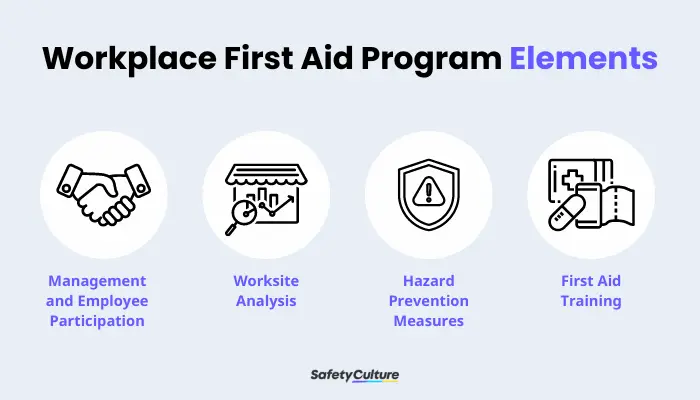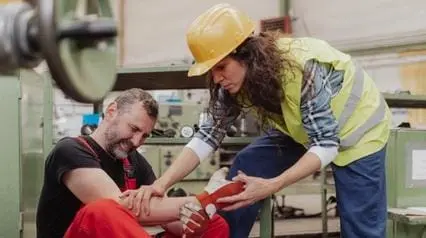What is First Aid in the Workplace?
In work settings, first aid refers to the urgent, temporary care given to a person immediately after an injury occurs. It utilizes emergency aid measures to stabilize the employee’s condition while waiting for a healthcare provider to arrive. While it cannot replace professional medical assistance, first aid in the workplace is vital for keeping workers safe until they receive full medical attention.
Why is it Important?
Workplace first aid is an essential part of an organization’s health and safety management system for various reasons. First, it helps save the workers’ lives when no medical personnel is present at the worksite. For example, correctly performing Cardiopulmonary Resuscitation (CPR) on those suffering from cardiac arrest can increase their chances of survival.
Moreover, with proper first aid training in the workplace, employees can swiftly tend to accidents and injuries as they happen and prevent them from getting worse. It also equips them with the necessary know-how for handling medical emergencies, such as assessing situations and contacting emergency care providers. This way, injured individuals can quickly get the help they need to recover faster and return to work in a healthier state.
Elements of a Workplace First Aid Program
A robust first aid program in the workplace consists of the following elements:

Management and Employee Participation
When establishing first aid programs at work, one of the first things to secure is everyone’s commitment to workplace safety. On the top level, decisive leadership is crucial to creating, implementing, and evaluating first aid policies and procedures. Employee involvement, on the other hand, is key to actually carrying things out on the ground level.
Worksite Analysis
Aside from ensuring buy-in from stakeholders, it’s also important to clearly identify the first aid requirements for the workplace. This can be done by carefully assessing business operations to spot existing hazards and anticipate conditions that can put workers at risk of injuries. Examples of these workplace hazards include:
- Manual handling tasks
- Electrical works
- Slips, trips, and falls
- Working at height
- Equipment and machinery
- Hazardous chemicals
- Tree work and outdoor work
- Workplace violence
Information about these matters can be retrieved from the following sources:
- Incident and accident reports
- Near-miss reports
- Risk assessments
- Health and safety inspections
- Regulatory injury and incident logs (e.g., OSHA 300 form, RIDDOR report)
Hazard Prevention Measures
Upon determining hazards that could lead to work-related injuries and illnesses, the next step is to devise preventive and control measures. When designing workplace first aid programs, it’s best to consider the following actions:
- Consulting with emergency medical experts and first aid providers for best practices
- Weighing options for control measures using the hierarchy of controls
- Utilizing a hazard control plan for the first aid program
- Assessing risks according to their type, severity, and likelihood of occurrence
- Providing adequate first aid equipment, facilities, and resources
First Aid Training
The final key component of effective first aid programs is first aid training. Training programs equip employees with the skills and knowledge to properly respond to health emergencies at work. Ideally, they should reflect the specific needs and conditions of the workplace.
When selecting first aid training providers, it’s best to check the guidelines from local health and safety agencies. This ensures that the training program complies with the laws and regulations for first aid in the workplace.
Best Practices
After discussing the elements of workplace first aid programs, it’s time to put them into practice. Here are 5 tips for planning, implementing, and evaluating first aid programs at work:
Find the Most Common Work-Related Medical Issues
Aside from workplace risks and hazards, it also helps to identify work-related injuries and illnesses that commonly occur on your site. To gather information about this, you can revisit incident reports and similar records.
Some examples of common occupational illnesses and injuries include:
- Asthma attacks
- Allergic reactions
- Cardiac arrests
- Seizures
- Strokes
Keep Your First Aid Kits Fully Stocked
In order for first aid responders to properly assist an injured or ill employee, they must have the right supplies and tools readily available. Thus, it’s a must to maintain a fully-equipped first aid kit that everyone can easily access and retrieve during emergencies. The contents will depend on the results of your first-aid assessment.
Moreover, make sure to place an easily noticeable first aid signage to help employees easily locate the kit when they need it.
Use a First Aid Kit Checklist
Keeping track of your first aid kit inventory levels can become easier with the help of a handy checklist. This tool lets you record the contents of your kit, making it easier to keep track of their expiration dates and inventory counts. With a first aid kit checklist, you can easily identify which supplies need to be replaced or restocked.
Create Your Own First Aid Checklist
Eliminate manual tasks and streamline your operations.
Get started for FREEHave Enough First Aid Providers at Worksites
Aside from your first aid supplies, it’s also important to have enough people trained to administer first aid. The headcount will depend on several factors, including the needs assessment results and the level of risk present in the workplace.
Still, it pays to encourage everyone at work to undergo first aid training so that they can keep themselves safe and assist others during emergencies.
Review Your First Aid Program Periodically
Lastly, first aid programs must be reviewed regularly to determine if they still effectively address common first aid problems. By spotting pain points and areas for improvement, your company can readily modify your occupational first aid practices to reflect changes in existing processes and update them according to the most current best practices and techniques.
Local Legislation
Regulatory requirements for first aid in workplace settings may differ from one place to another. To help you get started, here are a few examples of local first-aid legislation around the world:
- United States (US) – Occupational Safety and Health Administration (OSHA) First Aid Standard (29 CFR 1910.151)
- United Kingdom (UK) – Health and Safety (First-Aid) Regulations 1981
- European Union (EU) – Directive 89/391/EEC – OSH “Framework Directive” (Section I, Article 8)
- Australia – Model Code of Practice: First Aid in the Workplace
- France – Labor Code Articles R4224-14 to R4224-16 (First Aid and Rescue Equipment)
- Ireland – Safety, Health and Welfare at Work Regulations 2007 (Part 7, Chapter 2)
- Singapore – Workplace Safety and Health (First-Aid) Regulations
FAQs about First Aid in the Workplace
First aid requirements generally vary from one workplace to another. Some of the factors to consider when making this decision are the following:
- Nature of the work
- Types of workplace hazards
- Size and location of the worksite
- Workforce headcount and distribution
- Working arrangements (e.g., remote, traveling, lone workers)
- Distance of the worksite to a healthcare facility
First aid procedures for workplace injuries should be delivered by trained employees. They must be able to assess the victim’s situation and administer initial medical care as needed. Untrained workers are advised not to step in, as they can put the injured person at further risk.
Recordkeeping for first aid incidents usually depends on the organization’s place of operations. For example, OSHA’s revised recordkeeping rule no longer requires documentation for first aid incidents. However, businesses in Canada must keep written records of injuries and aid given.
Whether required or not, it’s still a good practice to document first-aid procedures for workplace incidents, as it provides valuable insight to continually improve your first-aid practices.
At its basic form, a first aid kit in the workplace should include the following items:
- Bandages, splints, and wraps
- Treatments
- Tools and supplies
- First aid guide
This type of first aid kit works best for low-risk workplaces. On the other hand, high-risk and remote worksites may need more than the basics in their first aid kits. They can tailor these kits to cater to specific risks in their operations.



